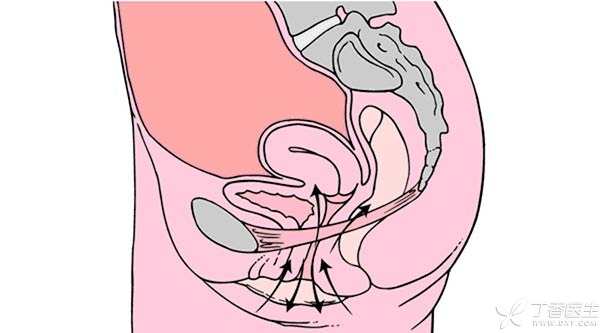
Have you ever heard of the Kegel movement?
Kegel exercise has significant effects on pelvic floor dysfunction diseases such as urinary incontinence, but more people may be concerned that this exercise can also improve vaginal relaxation (am I right? ).
However, due to the special location of the pelvic floor muscle group, some people may not be able to understand the specific method and thus doubt the effect. Below, Dr. Clove will give a detailed introduction to the correct way Kegel moves.
Is the Kegel Movement what?
Kegel exercise, also known as [pelvic exercise], is a simple exercise that can be carried out anytime and anywhere.
The core of this exercise is to repeatedly scale the pelvic floor muscle groups to enhance the strength of these muscle groups, so as to better support pelvic organs such as uterus, double appendages, bladder, small intestine and rectum, which can improve postpartum urinary incontinence and enhance [suction] there.
Where exactly do you want to exercise?
Pelvic floor muscle group? Does it sound abstract?
Indeed, due to the special position of the pelvic floor muscle group, some people may not be to the purpose of the specific method, thus doubting the effect.
Come on, let’s look at the picture first.

If you do the right thing, you will feel that the muscles are sucking up in the direction of the arrow in the above picture. If you put a finger in and feel that the finger is wrapped tighter and there is an upward force, then use the right force.
You can also try to suspend urination during urination. At this time, you feel that it is the place where exercise is needed to contract muscle groups.
Shh… don’t talk, feel…
Well, don’t tell me I don’t know which hole to put my finger in.
How to Carry out Kegel Movement Correctly?
1. Don’t stick to posture and location
Kegel can do sports anytime and anywhere, but as a beginner, it is easier to lie flat.
When you become more and more skilled, whether you are sitting at your desk or lying on the sofa at home, you can start exercising quietly.
Insist on taking it as a daily [compulsory course] and you will observe the effect faster.
STEP 2 Stick to it step by step
At first, you can try to contract the muscle group for 5 seconds, relax for 5 seconds, repeat for 4 to 5 times, then gradually extend to contract for 10 seconds and relax for 10 seconds, repeat for more than 10 times, three groups per day, and persist for at least 8 weeks.
Step 3: Concentrate
Focus on the contraction of pelvic floor muscles!
Don’t contract your abdomen at the same time!
Don’t shrink your thighs at the same time!
Don’t shrink your hips at the same time!
At the same time, don’t hold your breath… … …
Repeat the wrong action, tired is tired, but it is useless. Only by adjusting the rhythm of breathing and contracting muscle groups can the best effect be achieved.
Note: Do not exercise by suspending urination for a long time, which may lead to incomplete emptying of urine and increase the risk of urinary tract infection.
Why do you want to play Kegel?
Although we do not feel the existence of pelvic floor muscle groups, they are playing a role all the time to ensure the smooth progress of daily life.
It is precisely because of [heavy responsibility] that many factors in life will cause the pelvic floor muscles to be overwhelmed and weak:
- Pregnancy; Delivery (here not only refers to natural delivery, but also includes cesarean section, don’t think cesarean section can [avoid a bullet]); Pelvic surgery; Natural aging; Too hard stool; Long-term chronic cough; Overweight.
The strength of pelvic floor muscles is too weak, which will affect the normal functions of many human bodies. It is necessary to do some targeted training.
Which situations should I exercise?
If the following conditions occur, it means that the muscle strength of the pelvic floor has decreased, and it is necessary to step up exercise:
- Stress urinary incontinence: leakage of urine when sneezing, laughing or coughing; Urinary incontinence: When urinating urgently, one cannot control oneself and a large amount of urine flows out involuntarily; Fecal incontinence: Also known as anal incontinence, it also includes uncontrollable gas discharge.
Both pregnant and postpartum women are suitable for Kegel exercise, which are also high-risk groups for urinary incontinence.
However, if severe urinary incontinence has occurred, Kegel exercise is not the first choice for improvement, and urological consultation should be conducted in time.
In addition, Kegel’s exercise is not effective on [filling urinary incontinence], that is, when the urine in the bladder is full, a small amount of urine will involuntarily leak out.
How long can exercise be effective?
Many people will ask this question… … …
In fact, instead of worrying about the effect, it is better to stick to it every day. As long as the movements are correct, obvious effects can be observed after weeks or months, such as a decrease in the number of urinary incontinence.
If you want to obtain more long-term benefits, you should stick to it.
What should I do if I encounter problems in exercise?
Some people can’t see the effect, it may be that they don’t stick to it well enough, it may be that the method is improper, or it may be that they need other treatment schemes.
The global prevalence rate of female urinary incontinence is close to 50%, and the relevant data in China are roughly the same, but the consultation rate is very low, because many women feel shy about it.
If the situation does not improve after several weeks of continuous exercise, you should consult a doctor in time. Don’t be too shy, don’t worry, doctor what has seen it.
Clove Garden is exclusively authorized and cannot be reproduced without permission.
Source: Shutterstock.com
